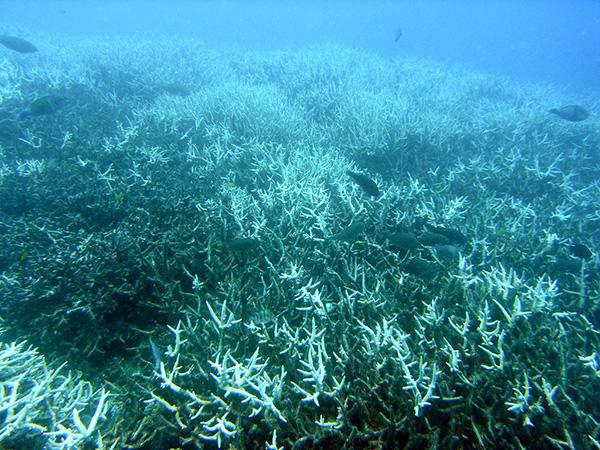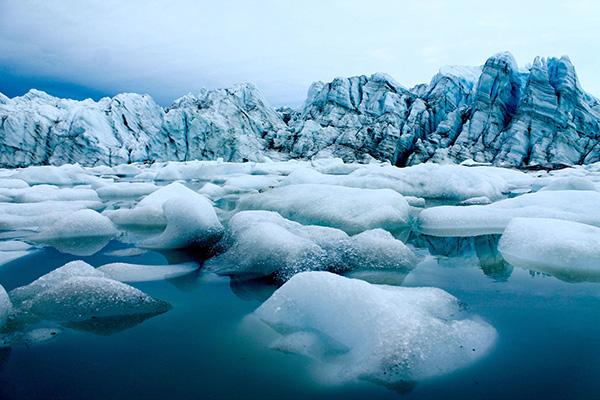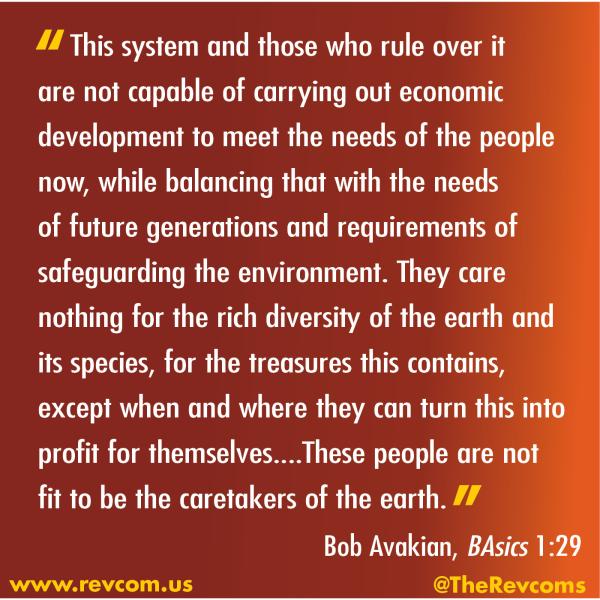
The Amazon rainforest, the largest rainforest in the world, is burning—causing deadly harm to what is known as the “lungs of the planet.” The fires are set deliberately by farmers and agribusiness companies with the backing of the Brazilian government. If this continues, the results would be horrific: extinction of tens of thousands of species and further acceleration of global climate change. Above: Jacundá National Forest, near the city of Porto Velho, August 25, 2019 (Photo: AP)
I. Indicators of Accelerating Crisis, Devastation, and Great Power Criminality
*2019 was the second hottest year on record. Since the 1960s, each decade has been warmer than the previous decade, by significant amounts. By 2016, when the Paris Agreement on Climate Change was signed by more than 190 countries pledging to curb greenhouse-gas emissions, the planet had already passed a precipitous threshold of carbon dioxide in the atmosphere: 400 parts per million.
NOTE: Half of all global carbon emissions since the industrial revolution (dating to 1751) were produced between 1988 and 2014—that is, since climate scientist James Hansen presented his seminal findings on global warming, and since the convening of UN summits on climate change. And in the almost four years since the signing of the Paris Agreement, not one major carbon-emitter is close to meeting stated goals. Meanwhile, the country responsible for the greatest amount of cumulative carbon dioxide emissions in the atmosphere—the United States—is headed by a fascist regime that denies the reality of global warming altogether, while ramping up fossil-fuel production.

The Montiva Refinery, Port Arthur, Texas, largest oil refinery in North America. The Texas Gulf Coast has four of the 10 biggest oil and gas refineries in the United States. (Photo: AP)
In the following section, I draw from Bill McKibben’s article “A Very Hot Year”1 and step back to show how the underlying dynamics of capitalism are expressed.
*McKibben observes that the models used by scientists 20 and 30 years ago to predict warming have proven to be remarkably accurate—some 1 degree Celsius, as averaged across the globe, so far. BUT the impact/effect/severity of global warming was far underestimated. The planet has notably suffered the loss of more than half of sea ice in the Arctic, and the onset of the collapse of coral reefs. McKibben cites a November 2019 European study identifying nine major tipping points focused on Greenland and Antarctic ice sheets, the boreal forests and permafrost of the north, and Amazon rainforests and corals of the tropical latitudes. The conclusion is that the risk of “abrupt and irreversible changes” was much higher than projected by the earlier research.

Coral reefs have declined 50% in the last 150 years. All but 1 percent may be lost in the next decades if climate change continues. The Northwest Hawaiian Island coral reefs alone support 7,000 species of fishes, invertebrates, plants, sea turtles, birds, and marine mammals.

Ice Melting on Denmark Island, Greenland, August 6, 2018. (Photo: Matt Osman/Woods Hole Oceanographic Institution)
NOTE: No emergency alarm has gone off, no radical rethinking, no bold action at the highest levels of governance.
*The U.S. is the world’s biggest oil and natural gas producer (for the record, the “climate-conscious” Obama administration presided over the largest increase in oil production in U.S. history and under Obama the U.S. became the largest natural gas producer in the world). The U.S. is also expected to produce 80 percent of the new supply of oil and gas over the next five years.
NOTE: This projection cited by McKibben predates the COVID-19 pandemic and the sharp contraction of the world economy. But, tellingly, in the early stages of the pandemic, Russia and Saudi Arabia were dueling it out in a price war to secure and expand global oil market shares. How? By pumping more oil, which then threatened the global market position of the U.S. fossil-fuel industry. The Trump/Pence regime moved to bolster U.S. oil prices. But as the pandemic worsened and oil consumption fell sharply, oil prices crashed.
*To meet the Paris Climate Summit goal of limiting temperature increases to 1.5 degrees Celsius, the world would have to cut emissions by 7.6 percent annually for the next decade. That would require an enormous slashing of fossil-fuel consumption. As McKibben observes, no individual country (and certainly not the global economy as a whole) has reduced carbon emissions at that rate in a single year.
NOTE: The reality is that an effective and coordinated commitment to sustain such a level of carbon reduction, continuously over an entire decade, collides with the short-term horizons of capital and the profitable fossil-fuel foundations of the world-imperialist economy... and smacks up against the boundaries of private/national-state decision-making in a world of competing capitals and national-imperialist states. Again, think about it: no major signatory to the Paris climate agreement is on track to meeting its goals. We live in a world in which non-renewables, including oil, coal, and natural gas, provide 80 percent of global energy.
II. A Contradiction Built into the Competitive-Private Relations of Capitalism as It Has Historically Evolved: Reliance on and Expansion of Fossil Fuels...
The Barriers to and Limitations of Green Technology in the Framework of This System
In his March 12, 2020 article, McKibben cites Financial Times calculations that in order to meet the 1.5 degree Celsius Paris target, and this is far from what is needed, the fossil-fuel industry would have to leave 84 percent of its reserves in the ground, effectively writing off their value. (Reserves refers to the estimated amount of crude oil controlled by private and state companies that can be brought to the surface under current technical and price conditions.)
Let’s examine why keeping 84 percent of fossil-fuel reserves in the ground is such an imponderable in the framework of capitalism-imperialism.
*The oil/natural gas energy companies/investors draw on finance to make huge fixed capital outlays (technical equipment, infrastructure, etc.): in order to explore for and develop their oil reserves... and ultimately to extract oil and natural gas at a profitable margin. There are “sunk investment costs” in these reserves. This refers to the social knowledge (engineering, etc.) that is privately deployed; seismic and oil-field development technology that is applied, transport infrastructure put in place—costs that cannot be recovered if the firm making those investments leaves the industry. At the end of the day, these investments are weapons in the capitalist battle for markets, expansion, and survival.
*There is this particularity in the oil and natural gas extraction sector: it takes years for individual fossil-fuel projects to become profitable... years for massive capital-intensive investment to be recouped by private owners.
That can only happen through continuous cycles of production. If those circuits of production-realization-new production do not continue—recoupment plus profit will not materialize. There is compulsion facing these individual units of capital to “make good” on these investments, which means developing and drilling oil from these reserves, producing and producing more—with all the adverse consequences for the well-being of the planet.
This capitalist calculus of profit-making and return on investment works against, effectively nullifies, a rational recommendation by climate scientists, and a most “sensible” demand by many climate activists: to “keep the oil in the ground.”
This profit-making calculus, and it flows from the expand-or-die compulsion of capital, is also part of the reason that the idea and prediction bought into by many progressive people—that once the price of clean-renewable technology came down, we’d surely be on a different (a positive) trajectory—has proven to be utterly untrue.
*A salient observation on green energy by David Wallace-Wells in his 2019 book, The Uninhabitable Earth: Life After Warming (a recommended read):
“[T]he much-heralded green-energy ‘revolution’ ... has not even bent the curve of carbon emissions downward. We are, in other words, billions of dollars and thousands of dramatic breakthroughs later, precisely where we started when hippies were affixing solar panels to their geodesic domes. That is because the market has not responded to these developments by seamlessly retiring dirty energy sources and replacing them with clean ones. It has responded by simply adding the new capacity to the same system. Over the last 25 years, the cost per unit of renewable energy has fallen so far that you can hardly measure the price today, using the same scales (since just 2009, for instance, solar energy costs have fallen more than 80 percent). Over the same 25 years the proportion of global energy use derived from renewables has not grown an inch. Solar isn’t eating away at fossil-fuel use, in other words, even slowly; it’s just buttressing it. To the market this is growth; to human civilization, it is almost suicide.” (Emphasis added, p. 178)
*There is what is called “path-dependency”: So much capital is tied up in fossil fuel, as fossil fuels have been cheap and widely available; and as fossil-fuel-based production has been foundational to the profitable functioning of the global capitalist-imperialist system, including its global supply chains with their “dirty” (fossil-fuel-based) infrastructure. Moving outside the energy industry, the auto industry continues to manufacture vehicles with gasoline-fueled, internal combustion engines—with research expenditure and infrastructure established for gasoline-fueled transport and machines. This “path” of fossil-fuel-based production is self-reinforcing, and has been further reinforced with the massive expansion of hydraulic fracking of petroleum and natural gas (and this sector’s huge fixed capital outlays). What is being described is a major barrier to “unlocking” fossil-fuel energy systems.
*The problem of green energy in the framework of capitalism-imperialism
Renewable energy, like wind and solar power, has been scaled up commercially. But these renewables answer to the goal of generating profit and are also objects of market share competition. So you have the situation in which both the Obama and Trump administrations imposed tariffs (a tax) on Chinese-manufactured solar panels. And in the current pandemic-slowdown of the world economy, firms in the solar and wind industries are scrambling to survive and competing for bank and government-backed loans.
Green energy/technology as it has developed is stamped by the structure and workings of the system. The current manufacture of solar panels involves the mining and fusing of quartz and coal, and depends on global supply chains with significant inputs of fossil fuel. The batteries powering GM and Tesla electric vehicles would not function without cobalt that is mined under horrific conditions of super-exploitation, including child labor, in the Democratic Republic of Congo. Europe is establishing wind farms in North Africa, in what amounts to a kind of “green-energy colonialism.” Solar panels help power the prison and torture camp at the U.S. naval base at Guantánamo in Cuba. All of which is to say that harnessing a less fossil-fuel-based infrastructure to the existing imperialist economy of the U.S., with its unsustainable levels of consumption and its plunder of the planet, is NOT a good thing for humanity and for the earth.
*A brief aside on innovation and “risk taking.” The ideologues of capitalism hail its “risk-taking” qualities: “savvy entrepreneurs” who take “bold gambles” and “venture capitalists” who go where others dare not go. But the one “risk” that is not taken, that will never be taken... is that which does not follow the logic of profit and empire, the very logic that is destroying the planet.
*Oil is a strategic commodity. Oil is bigger than ExxonMobil, bigger than the money-slinging, right-wing oil-political donor and operative Charles Koch, and bigger than the major banks that have frenetically financed fossil-fuel’s wave of capital expansion of the past decade. Oil is a strategic commodity. Control over oil supplies and oil markets brings with it leverage over the world economy. Oil is central to the military and war-making capabilities of U.S. imperialism. It is a strategic weapon of rivalry and intimidation. For example, the U.S. imperialists, beginning with the Obama administration, stepped up oil and natural gas production to increase maneuvering room against imperialist Russia, and to intimidate countries like Iran and Venezuela—that depend on oil sales as their economic lifelines—into submission.

U.S. F-16 Fighting Falcons on a patrol mission over Afghanistan, November 29, 2019. (Photo: USAF/SMJenkins)
For all of the reasons gone into—the profitability of oil-based production, the fixed capital tied up in it and “path dependency,” the role of oil as a strategic commodity—along with other factors, capitalist markets and the capitalist state have NOT effected a rapid shift to “green technology.”
BUT ON THE BASIS OF MAKING A REVOLUTION THAT OVERTHROWS THIS SYSTEM... that establishes a new socialist state power and economy no longer based on private ownership and exploitation—and that puts an end to the American empire, with its network of sweatshops and military bases—we will be able to decisively move away from fossil fuels. We can do that as a critical part (emphasizing that this is still only a part) of a radical, all-around reorganization of society and restructuring of the economy toward socialist sustainability.
A genuine socialist economy would allocate and re-allocate resources on a societal level. It would have the capacity to redirect and subsidize investment and effect dis-investment—and to consciously regulate growth. It can do that because the framework of public-state ownership enables you to socialize and centralize the surplus of society and to consciously steer and coordinate economic development through comprehensive, integrated planning, guided by the three goals/criteria set forth in the Constitution for the New Socialist Republic in North America authored by Bob Avakian and the associated Some Key Principles of Socialist Sustainable Development.
How Would a Revolutionary Socialist Society Address the Environmental Emergency?
Excerpts from the Constitution for the New Socialist Republic in North America
- A. The Economy.
- B. The Environment.
- Article IV. The Economy and Economic Development in the New Socialist Republic in North America.
- Section 5. The System of Public-State Ownership is the Foundation of the New Socialist Economy.
This Revolution special issue focuses on the environmental emergency that now faces humanity and Earth’s ecosystems. In this issue we show:
- the dimensions of the emergency...
- the source of its causes in the capitalist system, and the impossibility of that system solving this crisis...
- a way out and way forward for humanity—a revolutionary society in which we could actually live as custodians of nature, rather than as its plunderers.
As part of this issue see: Some Key Principles of Socialist Sustainable Development
Also available in brochure format (downloadable PDF)
III. “Public Goods” in a Private Capitalist World
Humanity is part of nature. We evolved with and are dependent on the physical environment and its interaction with other living things. Well-functioning ecosystems provide us with oxygen, food and fuel, materials essential to survival and well-being, protection from storms, disease, and solar radiation, regulation of water and climate. Not to mention aesthetic wonder and inspiration for art.
*The economic models and pricing system of capitalism cannot capture the true measure of these elements of nature. They systematically “undervalue” nature because, historically, these benefits of ecosystems are provided “free” as “public goods”—and have been systematically overexploited as imperialism relentlessly and massively commodifies more and more of nature. Export-production in poor countries rich with natural resources is based on the exploitation/processing of “public goods,” such as mangrove forests turned into commercial shrimp farms. But export prices do not factor in “environmental costs”: their short- and long-term impacts locally and globally. The problem is exacerbated by the fact that rich countries disproportionately use what are called “environmental sinks”—like the atmosphere and tropical rainforests—to absorb their high levels of carbon emissions.
In short, profit-maximizing capital has massive negative effects “external” to its private boundaries of ownership, operations, costs, and earnings. These are unpaid environmental externalities.
The Destruction of the Planet by Capitalism-Imperialism, by Bob Avakian, an excerpt
IV. The Rich/Poor Country Divide and Climate Change
*The U.S. and Western Europe have been directly responsible for 52 percent of all carbon dioxide emissions since the Industrial Revolution. The U.S. alone has accounted for 25 percent and is, in the words of climate scientist James Hansen, “by far, more responsible than any other nation” for global warming. The poorest half of the world’s population—3.5 billion people—is responsible for just 10 percent of cumulative carbon emissions.2
*By 2050 global warming might create as many as 1 billion climate refugees, most from the poor nations of the world—according to projections from the UN International Organization for Migration.
*In the years 1961-2000, countries in the low, middle, and high income groups were responsible for 13%, 45%, and 42% of greenhouse-gas emissions, respectively. The resulting “climate damages” were estimated to be distributed 29%, 45%, and 25%, respectively.3
*During the past 50 years, some 69 percent of deaths from extreme weather-related events—such as droughts, wildfires, floods, landslides, heat waves, and large storms—have taken place in poorer countries. Since 2000, this death rate in poor countries has been seven times higher than in wealthier countries.4
*And one little known but significant contributor to this situation is that major U.S. transnational corporations like Walmart, GM, and Apple outsource pollution to China, Bangladesh, countries in Central America, and elsewhere. America’s total carbon emissions worldwide are actually 14 percent higher than the domestic numbers reveal, when you factor in the greenhouse gases emitted by the manufacture of cars, clothing, and other products overseas but that are consumed in the U.S.5
*A 2019 study by Stanford University scientists estimates that the gap between the economic output of the world’s richest and poorest countries is 25 percent larger today than it would have been without global warming; and from 1961 to 2010, global warming decreased the wealth per person in the world’s poorest countries by 17-30 percent.6
*In the world today, nearly 70 million refugees have been forced from their homes: 23 million of them, about a third of the total, and almost all from Third World countries, were displaced by extreme weather events that are becoming more common and destructive because of global warming. The number of Central American migrants forced to flee their countries, due in significant part to climate change, increased five-fold between 2010 and 2015. These were unusually dry years, leaving many without enough food.7
V. Imperialist Global Trade, Agro-Industry, and the Destruction of Species
In May 2019, the UN Intergovernmental Science-Policy Platform on Biodiversity and Ecosystem Services issued a preliminary report. Its crucial finding was that one million species face extinction in the next few decades unless action is taken to reduce the intensity of drivers of biodiversity loss. The report identifies five factors driving extinction and biodiversity loss: changes in land and sea use; unsustainable overuse; climate change; pollution; and invasion by non-native species. And what are some of the key drivers of these drivers? This is summarized in the revcom.us article “Capitalism-Imperialism Is Strangling Life on the Planet.”8

Sea otter, among the species endangered due to destruction of habitats and oil spills which contribute to their fur being unable to keep them warm. (Photo: Marshal Hedin, San Diego/Wikimedia Commons)
*Global trade. The UN report points out that global trade has increased ten-fold in the last 50 years. This is a product of profit-driven imperialist globalization and the forging of a globally integrated, cheap-labor manufacturing/sweatshop economy and the extraction of raw materials. Goods produced in the oppressed countries of the global south are transported worldwide in huge container ships consuming massive amounts of fuel oil that contributes to pollution and global warming. These supply chain/transport systems require increased infrastructure, such as roads and pipelines, which split up ecosystems (having effects like impeding the ability of animals to travel with changes in seasons). Global trade also increases the spread of invasive species (not native to a region). These invasive species have increased by 70 percent since 1980 alone, disrupting and often causing great damage to ecosystems. One invasive pathogen spread in part by global trade is responsible for the extinction of at least 200 species of frogs around the world.
*Commercial-driven destruction of wetlands that often support high concentrations of animals. Many such wetlands have been drained to make room for industrial farming that utilizes toxic fertilizers and pesticides that poison land and water. Wetlands have been compromised by reckless residential and urban-industrial development that produces pollution and carbon dioxide accelerating climate change.
*Fossil-fuel-driven climate change. The report emphasizes that climate change is “increasingly exacerbating the impact of other drivers...that many species are unable to cope locally with the rapid pace of climate change, either through evolutionary or behavioral processes, and that their survival will also depend on the extent to which they are capable of dispersing, of following the appropriate climatic conditions and preserving their capacity for evolution.”
VI. A planet interconnected and integrated by capitalist-imperialist globalization is a planet of intensifying and accelerating eco-catastrophe... a planet on fire.
*Why? Because capitalism-imperialism, in its ruthless and anarchic pursuit of profit and competitive advantage, not only has ravaged the environment but is driven to continue to do so, releasing more and more carbon dioxide into the atmosphere in the ceaseless drive of competing blocs of capital for profit and more profit. This is a system in which fossil fuels are “cost effective.”
*And global warming is having cascading feedback effects: climate-driven crop failures and water shortages; diseases and plagues compounded by global warming—mosquitoes that can migrate to expanding tropical regions; mutating viruses; rising sea levels that endanger densely packed swaths of humanity in coastal cities; unbreathable air; acidification and warming of oceans that depletes fisheries and contributes to more frequent and intense weather events and disasters; the potential loss of one million species; climate refugees and resource-scarcity conflicts.
*Global interconnection without global cooperation. To quote again from The Uninhabitable Earth: “If you had to invent a threat grand enough, and global enough, to plausibly conjure into being a system of true international cooperation, climate change would be it—the threat everywhere, and overwhelming, and total.” (This was before COVID-19, but this is the world we are living in!) And what we see is the utter opposite of “true international cooperation.” This inability to coordinate and cooperate is a function of capitalism-imperialism, of globalized capital anchored to national markets and safeguarded by national-imperialist states, a world system divided into oppressor and oppressed countries, and rent by antagonistic class and social division. A system in which private ownership and appropriation are in conflict with socialized and interconnected global production.
*It doesn’t have to be this way. Only a revolution to overthrow this system and establish a new socialist state power and economy, to create a socialist society as a transition to global communism—a revolution guided by the new communism developed by Bob Avakian—gives humanity any real chance to save the planet. Only by making this revolution can we fit ourselves to be caretakers of the planet for current and future generations, and create a true world community of humanity.
How Would the Revolution Deal With the Climate Crisis?
A Q&A with Raymond Lotta
1. New York Review of Books, March 12, 2020. [back]
2. James Hansen, Climate Change in a Nutshell: The Gathering Storm, 18 December 2018, p. 15; “World’s richest 10% produce half of carbon emissions while poorest 3.5 billion account for just a tenth,” Oxfam, December 2, 2015. [back]
3. Data from U.T. Srinivasan, et al., “The debt of nations and the distribution of ecological impacts from human activities,” Proceedings of the National Academy of the Sciences of the United States, February 5, 2008. [back]
4. “Time to redress the globally unjust cost of climate change,” International Institute for Environment and Development, September 2019. [back]
5. Brad Plumer, “You’ve Heard of Outsourced Jobs, but Outsourced Pollution? It’s Real, and Tough to Tally Up,” New York Times, September 4, 2018. [back]
6. “Global warming has increased global economic inequality,” Noah S. Diffenbaugh and Marshall Burke, Proceedings of the National Academy of Sciences of the Unites States, May 14, 2019. [back]
7. The climate crisis, migration, and refugees, Brookings Institution, July 25, 2019; Groundswell: Preparing for Internal Climate Migration, World Bank, August 2018; “Central American Farmers Head to the U.S., Fleeing Climate Change,” New York Times, April 13, 2019; “Climate Change Threatens the World’s Food Supply, United Nations Warns,” New York Times, August 8, 2019. [back]
8. “Capitalism-imperialism is Strangling Life on the Planet,” revcom.us, May 13, 2019. [back]


